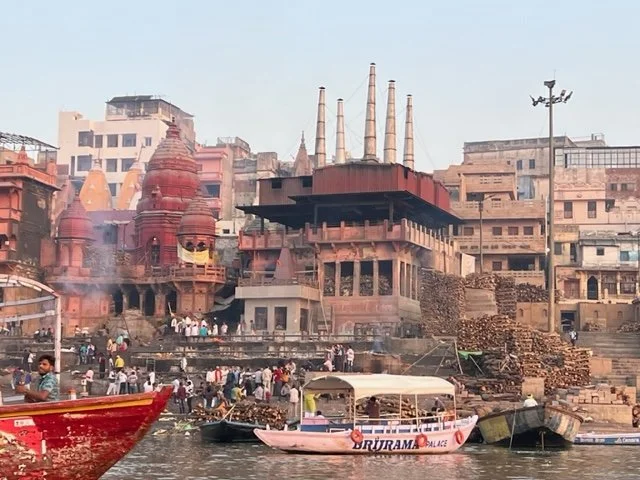Darshan
Sahdu (Hindu ascetic) in Banaras (or Varanasi, religious city and pilgrimage site on the Ganges). Thank you Adam Grotsky, head of USIEF (U.S.-India Education Foundation that administers Fulbright grants) for connecting us with amazing Banaras guide Ajay.
I first ran across the word darshan (from Sanskrit — to see, vision, glimpse) when reading a book about the history of India, Freedom at Midnight (Larry Collins and Dominique Lapierre). The authors were describing a procession of young Hindu and Moslem girls who started walking at midnight to Calcutta “to take darshan from Gandhi, a kind of mystic communion engendered by being in the presence of a great spirit” in the bloody aftermath of partition.
Since arriving in Delhi, I had been thinking about both the power of seeing and the power of being seen. As a white woman with blue eyes and light brownish hair (and at 5’5'“ tall for India) I stick out just about everywhere. I am noticed in the market, on the metro, and on the law school campus. I am different. And yes, as a foreigner, I have been made to feel special. People ask me where I am from, they peer over my shoulder when I’m on the metro and ask me about learning Hindi, and they ask me if they can take a selfie with me.
Although sometimes I don’t want to be noticed or talk about my Hindi lessons (especially because I really don’t know that much Hindi), it is also strange how you can get used to being special. And it’s not just casually being stared at because of my appearance; it’s also in professional settings among lawyers and law faculty. There is so much interest in my work, my research interests, my teaching, and my Fulbright grant. Being seen makes you feel like somebody.
And I also have watched the power of seeing — of being the seer. In addition to the grand temples, gurdwaras and dargahs here, there are what I call the “neighborhood” temples tucked away in corners of the city. My favorite, a small Sai Baba temple around the corner from my apartment, has been a source of pleasure and refuge. Sai Baba was an India spiritual master revered by both Hindus and Muslims who condemned discrimination based on caste or religion and concentrated his teachings on love, forgiveness, charity, inner peace, contentment and devotion to God.
I have watched people stop their cars and bow to the Sai Baba statue in the temple; walk into the temple briefly to see him, to bow to him; stop briefly on their walks to turn to him with a prayer and a small bow. I have watched how seeing gives a restful pause and comfort. One of Sai Baba’s favorite sayings was “Look to me and I shall look to you.”
I feel fortunate that my time in India has revolved around both seeing in a new way and being seen in a new way.
Banaras. One of my favorite places.
Aarti (Hindu offering of light) ceremony in Banaras.


